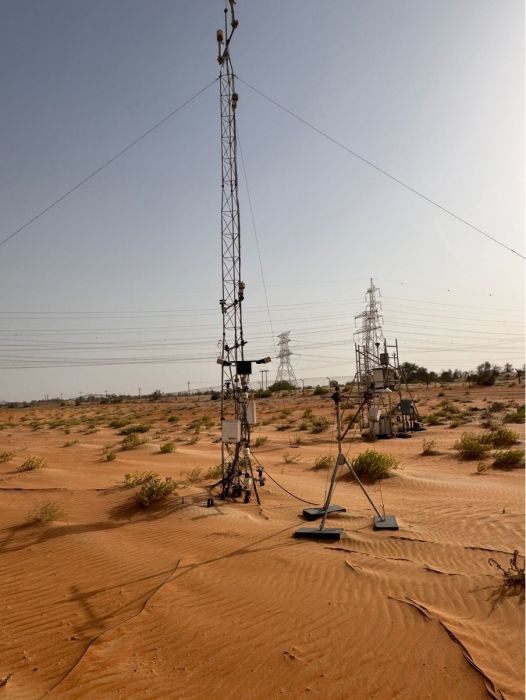
Overview
In the heart of the UAE’s Empty Quarter desert—one of the harshest and least hospitable environments on Earth—Emirates Tech (ETech) played a pivotal role in enabling groundbreaking environmental research. The Wind-Blown Sand Experiment (WISE) Phase-1, launched in the summer of 2022, set out to deepen scientific understanding of aeolian (wind-driven) processes in arid climates. The WISE experiment is supported by Khalifa University and the Federal Authority for Nuclear Regulation (FANR) in the UAE. ETech was chosen as the technical partner to design, deploy, and maintain the environmental monitoring systems that made this research possible.
The Challenge
The WISE project was situated deep within the Rub' al Khali (Empty Quarter) desert, an environment known for:
- Extreme conditions – scorching daytime temperatures, shifting dunes, powerful sandstorms, and intense solar radiation
- Scientific complexity – the need for continuous, high-resolution measurements of meteorological, soil, and aerosol parameters
- Remote deployment – with little margin for equipment failure and limited access for maintenance
The project's success hinged on maintaining robust, reliable instrumentation capable of withstanding the elements and providing continuous, high-quality data.
The Solution
To meet the project’s rigorous demands, ETech engineered and deployed a turn-key monitoring system based on a suite of Campbell Scientific instruments, selected for their proven performance in harsh environments.
The key equipment supplied and used included:
- Two CR1000X Measurement and Control Dataloggers, which provided the backbone of the system’s data acquisition and control
- One CELL215 Cellular Module, which enabled remote data transmission from deep within the desert
- One CS110 Electric Field Meter Sensor, which was used to monitor atmospheric electric field conditions
- Five WindSonic1 ultrasonic wind sensors, which captured wind speed and direction across multiple stations
- One CSAT3B 3-D Sonic Anemometer, which delivered detailed wind turbulence measurements
- Six 107 Temperature Probes, which precisely monitored ambient and surface temperatures
ETech designed and installed supplementary systems including power supplies, telemetry modules, and protective enclosures tailored to withstand sand, heat, and solar exposure. The Campbell Scientific equipment was carefully calibrated and aligned to ensure data accuracy over the life of the campaign.
The Results
Over the course of the project, the system successfully captured 38 distinct sand-saltation events—the transport of sand grains by wind—between September 2022 and February 2023. The most intense activity was recorded during midday periods, consistent with peak wind velocities.
The quality and consistency of the data collected enabled researchers to:
- Characterize the timing and drivers of sand and dust movement.
- Improve understanding of aeolian transport processes in hyper-arid regions.
- Contribute to peer-reviewed scientific output, including an AGU-published paper titled “The Wind-Blown Sand Experiment in the Empty Quarter Desert: Roughness Length and Saltation Characteristics” (DOI: 10.1029/2024EA003512), which acknowledges both ETech and Campbell Scientific.
The systems’ reliability proved vital: researchers were able to focus on data analysis and interpretation rather than troubleshooting hardware issues in extreme conditions.
The Benefits
- Enabling science in extreme environments: ETech proved that with the right technology and local expertise, advanced environmental monitoring can thrive even in the world’s toughest settings.
- Data-driven insights: The project yielded a high-quality dataset instrumental for research on desert geomorphology, atmospheric science, and climate modeling.
Conclusion
The WISE project illustrates how advanced environmental monitoring is no longer confined to labs or temperate climates. With rugged, reliable instrumentation and the right local partnerships, researchers can now push the boundaries of science—even in the world’s harshest environments.
Case Study Summary
Application
Studying sand and dust movementLocation
United Arab Emirates, particularly the Empty Quarter desertProducts Used
CSAT3B WINDSONIC1-L CS110 107 CELL215 CR1000XParticipating Organizations
Khalifa University, Federal Authority for Nuclear Regulation (FANR)Measured Parameters
Atmospheric electric field conditions, wind speed and direction, wind turbulence, ambient and surface temperatureParticipating Consultants/Integrators
Emirates Tech (ETech)View the PDF